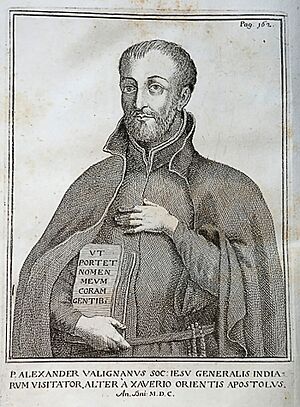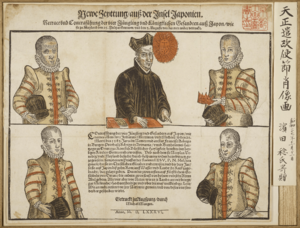Alessandro Valignano facts for kids
Quick facts for kids The Reverend Alessandro Valignano S.J. |
|
|---|---|

Alessandro Valignano, circa 1599.
|
|
| Church | Roman Catholic Church |
| Personal details | |
| Born | February 1539 Chieti, Kingdom of Naples |
| Died | January 20, 1606 (aged 67) Macau, Portuguese Macau |
Alessandro Valignano (born February 1539 – died January 20, 1606) was an Italian Jesuit priest. He was born in Chieti, which was part of the Kingdom of Naples. Valignano played a very important role in bringing Catholicism to the Far East, especially to Japan.
Contents
Early Life and Becoming a Jesuit
Valignano was born in Chieti. His father was a nobleman and a friend of Pope Paul IV.
He was a brilliant student at the University of Padua. He earned a law degree at just 19 years old. Later, he studied Christian theology. In 1566, he joined the Society of Jesus, also known as the Jesuits. The Jesuits are a religious order of the Roman Catholic Church.
Many in the Church believed he was the right person to spread the Christian message. In 1573, at age 34, he became the "Visitor of Missions" in the Indies. This meant he would supervise Jesuit missions in Asia.
Missions in India, Macau, and China
In 1574, Valignano sailed to Goa, India. He was now the official supervisor for all Jesuit missions in India, China, and Japan. He had a lot of power and could make many decisions on his own. He only answered to the head of the Jesuit order in Rome.
Valignano was very tall, which made him stand out. People in Japan were often amazed by his height. He developed a special way of spreading Christianity. This method is called "adaptationism." It meant trying to fit in with local customs and cultures. He believed this would help more people accept the Catholic faith. He wanted to avoid conflicts with local traditions.
When Valignano arrived in Portuguese Macau in 1578, he saw that no missionaries had succeeded in mainland China. He realized that Jesuits needed to learn the Chinese language to succeed. He asked for someone to be sent to Macau to study Chinese. Michele Ruggieri was sent first, and then Matteo Ricci joined him. These two became the first Europeans to deeply study China and its language.
In 1594, Valignano founded St. Paul's College in Macau. This college became an important center for learning.
Focus on Japan
Valignano spent a lot of time overseeing the Jesuit missions in Japan. He visited Japan three times: from 1579–1583, 1590–1592, and 1598–1603.
During his first visit in 1581, he wrote a book called Il Cerimoniale per i Missionari del Giappone. This book gave rules for Jesuits on how to behave in Japan. He wanted Jesuits to act according to the social class they belonged to. He believed this would earn them respect from the Japanese people. He arrived with an African servant named Yasuke, who later left to serve a Japanese lord.
Some people criticized the Jesuits for living a luxurious life in Japan. Valignano also worked hard to train Japanese priests. He believed that Japanese people should be able to become priests. He wanted them to be treated equally to European Jesuits.
Valignano was upset by how some missionaries treated the Japanese. He felt they often looked down on Japanese customs. He believed that leaders should set a good example. So, he started to change how the mission worked.
Learning the Language
Learning the Japanese language was a big challenge for missionaries. Before Valignano arrived, many complained that there was no proper language training. Some thought it was impossible for Europeans to learn Japanese well.
Valignano made it a rule that all new missionaries had to spend two years studying Japanese. By 1595, the Jesuits had even printed a Japanese grammar book and a dictionary. They also printed several books in Japanese, mostly about Christian saints. The dictionary was very detailed, with over 32,000 entries.
Valignano believed that Europeans should learn Japanese customs. He did not think the Japanese should have to change to fit Western ways.
Setting Up Seminaries
Valignano saw the need for Japanese priests. So, in 1580, an old Buddhist monastery in Arima was turned into a seminary. A seminary is a school for training priests. Here, 22 young Japanese converts began their studies. Another seminary was opened later in Azuchi.
In these seminaries, students learned both Latin and Japanese. They also studied moral theology, philosophy, and Christian beliefs. The seminaries were designed to blend Japanese style with European education. For example, they kept the traditional tatami mats and students wore kimonos. They ate Japanese food like white rice and fish.
Valignano wanted to train Japanese preachers who could connect with both their own families and the Jesuit order. These seminaries helped many Japanese converts join the Jesuits.
Nagasaki Port
As the mission grew, it needed more money. All the Jesuit schools, churches, and printing presses cost a lot.
In 1580, a local lord named Ōmura Sumitada became a Christian. He gave the port of Nagasaki to the Jesuits as a gift. At that time, Nagasaki was just a small fishing village.
The Jesuit leaders in Rome were surprised by this. They said Jesuit control of Nagasaki should only be for a short time. But Valignano and others decided to keep it. Nagasaki quickly became a safe place for persecuted Christians.
Under Jesuit control, Nagasaki grew into a major international port. It became as important as Goa or Macau. The Jesuits collected taxes on goods coming into Japan. They were very involved in the silver trade, sending Japanese silver to China for silk.
First Japanese Embassy to Europe
Valignano also started the Tenshō embassy. This was the first official Japanese group to visit Europe. He traveled with the Japanese converts, led by Mancio Ito, from Nagasaki to Goa. From there, he returned to Macau. The group continued to Europe, visiting Portugal, Spain, Florence, Rome, Venice, and Milan. They were welcomed with great honors.
Challenges with Rulers
The Pope eventually ordered the Jesuits to stop all trading activities. Valignano argued that without the trade, they could not afford to run the mission in Japan. He said they needed 12,000 ducats each year to cover their costs.
By 1580, the Jesuits supported about 150,000 people and 200 churches in Japan. They had 85 Jesuits and many Japanese helpers. All of this was very expensive. Japan was also a poor country at the time. So, Valignano allowed the mission to rely on the tax money from Nagasaki.
After 1600, the Jesuit mission in Japan faced difficulties. The rulers, first Toyotomi Hideyoshi and then the Tokugawa shogunate, began to persecute Christians. Tokugawa Ieyasu tried to stop all European contact with Japan after he came to power in 1603. Samurai and soldiers had to give up Christianity. Later, other people were ordered to do the same.
In 1636, Tokugawa Iemitsu issued the Sakoku edict. This law almost completely closed Japan off from the outside world. Japanese ships were not allowed to leave, and Japanese people who returned from abroad would be executed. These rules stayed in place until American Commodore Matthew C. Perry arrived in 1853.
Death and Legacy
Valignano died in Macau on January 20, 1606. He was buried at St. Paul's College.
He is remembered for paving the way for better relationships between Asian and European peoples. He believed in treating everyone equally. He greatly admired the Japanese people. He hoped Japan would become a leading Christian country. He once wrote that the Japanese "excel not only all the other Oriental peoples, they surpass the Europeans as well." Many historians consider him one of the most important Jesuit missionaries in the East after Francis Xavier.
See Also
- Francis Xavier
- Matteo Ricci
- Nanban period
- Chinese Rites controversy
- Yasuke, African man in service of Valignano who became an armed retainer of Oda Nobunaga


